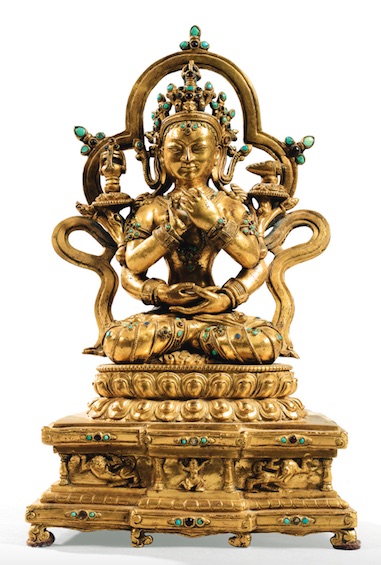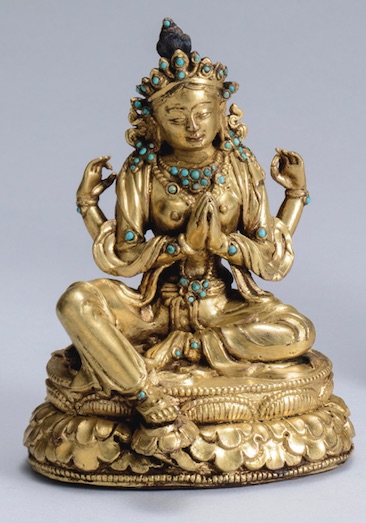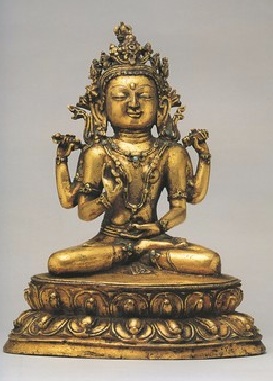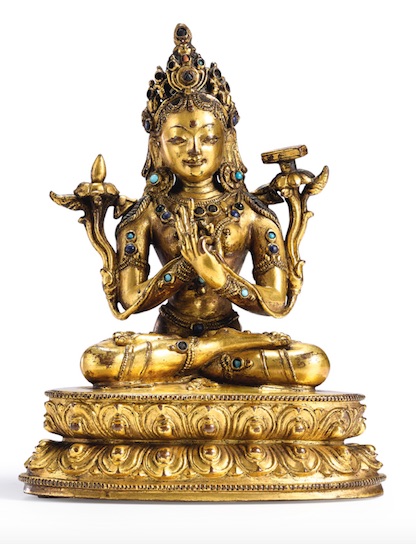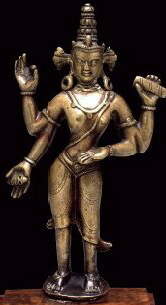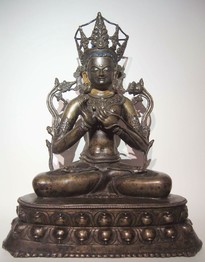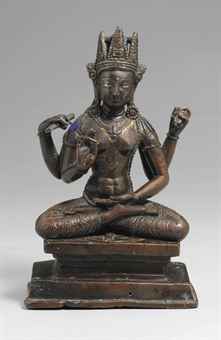
11th-12th century, Western Tibet, Prajnaparamita, brass, private collection, photo by Renaud Montméat on Asian Art
Popular in Western Tibet, the four-hand form of Prajnaparamita standing (rather than seated) typically has the lower left hand in the meditation gesture, the upper left holding a book, the lower right hand holding a vajra sceptre, the upper right doing a symbolic gesture which varies (here, she bestows patience). We will note the spectacular Western Tibetan multi-tier chignon and low tiara, stippled lotus print on her lower garment and her sash, stippled jewellery, incised geometrical decoration at the front of the base together with a typically Pala-style stance and gaze.

11th-12th century, Tibet, possibly Prajnaparamita, brass, taken at rKyang bu in the Tsang province, published in an article by Petra Müller on Asian Art.
A similar iconography, in a style related to the Guge kingdom, including a lower garment much shorter on one side and richly decorated with deeply carved roundels with a floral motif, an Indian-style belt with beaded festoons, a long foliate garland.
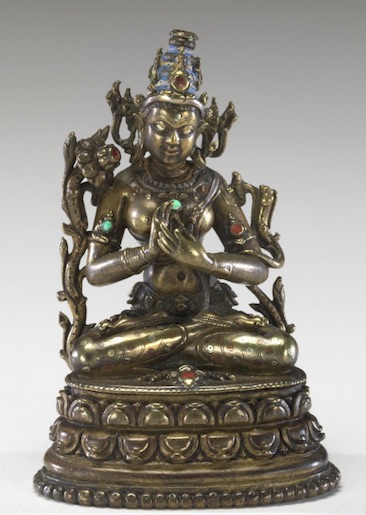
13th-14th century, Tibet, Prajnaparamita, copper alloy with silver, copper, stones, traces of paint, item at the 91.521 at the Virginia Museum of Fine Arts (USA).
A Pala-style Prajnaparamita in her one-head and two-arm form, flanked by a day and a (broken) night lotus, each normally topped with a manuscript, her hands making the ‘turning the wheel of dharma‘ gesture.

Circa 16th century, Tibet, Prajnaparamita, gilt bronze, private collection (Nepal on Global Nepali Museum ).
When the four-arm form makes the same gesture with her main hands, she holds a rosary in her upper right hand and a manuscript (sutra) in the other.

1350-1450 AD, Tibet, unidentified Buddhist goddess,(Prajnaparamita?) gilt copper, 31,2 cm, at the gTsug Lakhang in Lhasa, inventory nº 411. Update 16/12/21: circa 1267, Densatil, Prajnaparamita?, Fig. 32 in Jean-Luc Estournel ‘ s catalogue raisonné.
This female figure is seated on a double lotus atop a lion throne with a long-life vase at the front, her lower hands held in the meditation gesture. The lotuses next to her support a book and a conch shell. The shell is not normally associated with Prajnaparamita but we did see a similar sculpture with lotuses supporting a long-life vase (one of her main attributes) and a conch shell, identified as Prajnaparamita by Sotheby’s.

Circa 14th-15th century, Tibet (or Tibeto-Chinese?), Prajnaparamita, gilt copper alloy, private collection, photo on Cornette de Saint-Cyr.
She may also hold the vajra sceptre in her upper right hand instead of a rosary, in which case her main hands either hold a long-life vase or display two different gestures as above: the right hand does the teaching gesture, the other one does the meditation gesture.

16th century, Tibet, Prajnaparamita, gilt copper with turquoise inlay, made by a Nepalese artist, private collection, photo on Koller.
Flanked by lotuses, the flower on her right supports the vajra sceptre and she has a rosary in her right hand.

11th-12th century, Tibet, possibly Prajnaparamita, at rKyang bu in the Tsang province, metal, photo by Fosco Maraini, published in an article by Petra Müller























